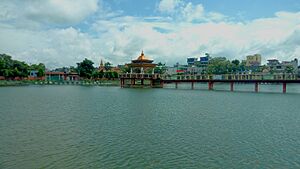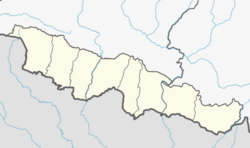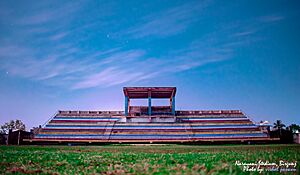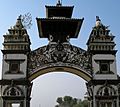Birgunj facts for kids
Quick facts for kids
Birgunj
वीरगञ्ज
Gateway of Nepal
|
|
|---|---|
|
Metropolitan City
|
|
| Birganj Metropolitan City | |
 |
|
| Country | |
| Province | Madhesh |
| District | Parsa |
| Founded | 1897 |
| Founded by | Bir Shamsher JBR |
| Area | |
| • Total | 75.24 km2 (29.05 sq mi) |
| Dimensions | |
| • Length | 19 km (12 mi) |
| • Width | 4 km (2 mi) |
| Elevation | 92 m (302 ft) |
| Population
(2021)
|
|
| • Total | 268,273 |
| • Rank | 5th largest |
| • Density | 3,565.56/km2 (9,234.8/sq mi) |
| Demonym(s) | Birganj |
| Languages | |
| • Official | Nepali |
| • Native | Bhojpuri |
| Time zone | UTC+5:45 (NST) |
| Postal code |
44300, 44301
|
| Area code(s) | 51 |
Birgunj (Nepali: वीरगञ्ज) is a big city in southern Nepal. It's located in Parsa District in Madhesh Province. The city is about 135 kilometers (84 miles) south of Kathmandu, Nepal's capital. It sits right next to Raxaul, an Indian town across the border in Bihar.
Birgunj is often called the "Gateway of Nepal" because it's a main entry point from India. It's also known as the "Commercial Capital of Nepal." This is because a lot of trade between Nepal and India happens here. The Tribhuvan Highway connects Birgunj to Kathmandu.
Birgunj was one of the first three cities in Nepal to become a municipality. On May 22, 2017, it was officially named a Metropolitan City. Today, Birgunj is one of Nepal's largest cities and the biggest in Madhesh Province. It's the fifth most populated city in the country.
Contents
What's in a Name?
Birgunj was created by joining several small villages around the Gahawa Mai Temple. This temple is still a very important spot in the city. The city was named after the Prime Minister at the time, Bir Shamsher Jang Bahadur Rana. That's how it got the name Birgunj!
A Look Back in Time
How Birgunj Started
Before Birgunj became a city, the main area in Parsa district was a place called Alau. In 1897, Prime Minister Bir Shamsher Jang Bahadur Rana decided to build a new market town. He changed the old name, Gahawa, to Birgunj.
He wanted to make Birgunj a busy place. So, he gave away free land and wood to people who wanted to build homes there. This helped the market grow quickly.
Modern Times
In 2006, Nepal's parliament announced that the country would become a secular state. This means the government would not favor any one religion. Birgunj was a key place where the Madhes Movement began in 2007 and 2013. These movements were about the rights of people living in the Terai region.
Where is Birgunj?
Land and Soil
Birgunj is located in the Terai plain, which is a flat area in northern Nepal. The city is shaped long and narrow. Its height above sea level ranges from 78 to 95 meters (256 to 312 feet). The soil here is very fertile, a mix of clay, silt, and sand.
Weather in Birgunj
Birgunj has a sub-tropical monsoon climate. This means summers are very hot and humid. The average yearly temperature is around 23.8 to 24.5°C (74.8 to 76.1°F). The city gets a lot of rain, especially from June to September. The average rainfall is about 1800 mm (71 inches) per year.
| Climate data for Birgunj (Simara Airport), (1991–2020) | |||||||||||||
|---|---|---|---|---|---|---|---|---|---|---|---|---|---|
| Month | Jan | Feb | Mar | Apr | May | Jun | Jul | Aug | Sep | Oct | Nov | Dec | Year |
| Mean daily maximum °C (°F) | 21.1 (70.0) |
25.8 (78.4) |
31.0 (87.8) |
35.1 (95.2) |
35.2 (95.4) |
34.5 (94.1) |
33.0 (91.4) |
33.1 (91.6) |
32.8 (91.0) |
31.9 (89.4) |
29.0 (84.2) |
24.1 (75.4) |
30.6 (87.1) |
| Daily mean °C (°F) | 14.4 (57.9) |
17.9 (64.2) |
22.4 (72.3) |
27.2 (81.0) |
29.2 (84.6) |
29.9 (85.8) |
29.4 (84.9) |
29.4 (84.9) |
28.6 (83.5) |
26.0 (78.8) |
21.5 (70.7) |
16.8 (62.2) |
24.4 (75.9) |
| Mean daily minimum °C (°F) | 7.7 (45.9) |
9.9 (49.8) |
13.8 (56.8) |
19.2 (66.6) |
23.2 (73.8) |
25.3 (77.5) |
25.7 (78.3) |
25.6 (78.1) |
24.4 (75.9) |
20.1 (68.2) |
13.9 (57.0) |
9.5 (49.1) |
18.2 (64.8) |
| Average precipitation mm (inches) | 14.1 (0.56) |
15.7 (0.62) |
17.3 (0.68) |
41.8 (1.65) |
135.5 (5.33) |
272.1 (10.71) |
549.5 (21.63) |
422.0 (16.61) |
254.8 (10.03) |
68.0 (2.68) |
4.5 (0.18) |
7.7 (0.30) |
1,803 (70.98) |
| Average precipitation days (≥ 1.0 mm) | 1.7 | 1.8 | 2.0 | 4.1 | 8.9 | 12.8 | 18.7 | 15.5 | 11.8 | 3.4 | 0.5 | 0.7 | 81.9 |
| Source 1: Department of Hydrology and Meteorology | |||||||||||||
| Source 2: World Meteorological Organization | |||||||||||||
Rivers and Water
The two main rivers in Birgunj are Sirsiya in the west and Singaha in the east. Both flow from north to south. During the monsoon season, these rivers can flood. In winter, their water levels are very low. The underground water is usually found about 9 to 15 meters (30 to 49 feet) deep.
People of Birgunj
Population and Languages
In 2021, Birgunj had a population of 268,273 people. It's the second-largest city in the Terai region and the fifth-largest in Nepal. Birgunj is also the main city of the Parsa District.
Many different languages are spoken here. In 2011, about 78.6% of people spoke Bhojpuri. Other languages include Nepali, Maithili, and Urdu.
Different Cultures and Religions
Birgunj is home to many different groups of people. The largest group is the Madheshi people. You'll also find people from various backgrounds like Kurmi, Yadav, and Newar.
Most people in Birgunj are Hindu (81.1%). A significant number are Muslim (17.9%). There are also smaller groups of Buddhists and Christians.
Education Levels
About 66.5% of the people in Birgunj can read and write. This shows that education is important in the city.
Birgunj's Economy
Birgunj is very important for Nepal's economy. It's known as the "Industrial and Commercial Capital of Nepal." Most of the trade between Nepal and India happens through this city.
Many factories are located in the Birgunj-Pathlaiya industrial area. These factories make things like medicines, clothes, plastics, and cigarettes. About 56% of what Birgunj produces is sent to the Indian state of Bihar.
The Birgunj Customs office collects a lot of money for the country. In 2004, the Birganj Inland Dry Port opened. This port helps manage the huge amount of goods traded here.
A new oil pipeline connecting India and Nepal was completed in 2018. This pipeline helps transport oil more easily between the two countries.
Fun Things to Do in Birgunj
Birgunj is a popular place for visitors, especially from India. The city has nice hotels, some with mini-casinos.
During the Chhath festival, many people visit Ghadiarwa Pokhari, a beautiful pond. Vishwa Buddha Vihar is another peaceful religious place outside the city. It's shaped like a stupa and has carvings of Buddha. It's a great spot for those who want to relax away from the city noise. Long ago, Buddhist monks used this place to rest during their journeys.
Just 33 kilometers (20 miles) from Birgunj is Parsa National Park. This park is home to amazing animals like Royal Bengal Tigers, Asian elephants, and One-horned Rhinoceros. You can take a bus from the city to visit the park in about an hour.
Getting Around Birgunj
Birgunj was built to be the closest city in Nepal to connect Kathmandu with India.
Trains
You can catch trains from Raxaul station (in India, next to Birgunj) to many big cities in India. These include Delhi, Kolkata, and Mumbai. This means Birgunj has good train connections to major Indian cities. There are also plans to build a railway line from Raxaul through Birgunj to Kathmandu in the future.
Air Travel
Birgunj is served by Simara Airport, which is about 9 miles (14 km) north of the city. You can find regular flights from here to Kathmandu and Pokhara. Nepal's second international airport is also being built at Nijgadh, not too far from Birgunj. There are plans for a "Fast track" expressway to connect this new airport, Birgunj, and Kathmandu.
Buses
You can find regular bus services from Birgunj to all major cities and towns in Nepal. These include Kathmandu, Pokhara, and Biratnagar. Local buses also help people get around inside the city. Some night buses from Birgunj to Kathmandu are very comfortable!
Tanga (Horse Carts)
Horse-drawn carts, called Tanga, have been a traditional way of getting around for a long time. Today, they are still a popular way to travel between Birgunj and its nearby Indian town, Raxaul.
Cargo Transport
A railway line connects Raxaul to the Sirsiya (Birgunj) Inland Container Depot (ICD). This depot started working in 2005 and is very important for moving goods between India and Nepal. Birgunj's dry port is a key place for surface cargo delivery to Nepal. The Tribhuvan Highway also connects Birgunj to Kathmandu, making it easy to transport goods.
Nepal and India have an open border, so people can move freely between the two countries. However, there is a customs checkpoint for goods.
Sports in Birgunj
Birgunj has its own stadium called Narayani Stadium. It's Nepal's second-largest stadium, built in 1981, and can hold 15,000 people. It's the home ground for Birgunj United FC, a football team that plays in the Nepal Super League.
Next to Narayani Stadium, there's a national-level Cricket Ground. It has a great field and pitch. Cricket tournaments are held here regularly, including night T20 matches. Several players from the Nepal national cricket team are from Birgunj, like Haseem Ansari and Aarif Sheikh. Cricket is the most popular sport in the city.
Learning in Birgunj
Birgunj has a long history of education. One of the first schools in Nepal, Trijuddha School, was started here. Today, it's the second oldest school in the country. It teaches in both English and Nepali and offers civil engineering diplomas.
Thakuram Multiple Campus was the first college established outside Kathmandu Valley. The city has grown a lot in education, with many new schools and colleges. Some notable ones include:
- Moonlight English Boarding School
- National Infotech College
- Vidhya Sadan Secondary School
Universities
- Madhesh University (Nepali: मधेश विश्वविद्यालय) (MU) was started in 2079 B.S. (Nepali calendar). It aims to provide higher education and help develop skilled people for the nation.
Media in Birgunj
Birgunj has many FM Community radio stations. Some popular ones are Narayani FM, Terai FM, and Radio Birgunj. There are also television stations like My Television and Birgunj Television (BTV). You can read local newspapers like Prateek and Loktimes Daily. Online news sites like Yatra daily are also from Birgunj.
Culture and Celebrations
Birgunj is a city with a rich mix of cultures. Many festivals are celebrated here, including Ganesh Chaturthi, Holi, Teej, Chhath, and Dipawali. Since there are also Buddhists, Buddha Jayanti is celebrated too.
The city has a diverse population, with many different ethnic groups. The Madheshi people are a large part of the population. You'll also find people who moved from Rajasthan, India, like the Marwari and Agrawal communities.
What's for Dinner?
The food in Birgunj is a mix of Nepali and Indian styles. Common meals include dal (lentil soup), bhat (rice), roti (flatbread), vegetable curry, and achar (pickle). Tibetan foods like momo (dumplings) and chowmein (noodles) are also very popular, especially among young people.
Adarsh Nagar is famous for its street food. In the evenings, you can find many food vendors selling delicious snacks like Pav Bhaji (bread with vegetable curry) and Chaat (a potato-based snack).
Famous People from Birgunj
- Ranu Devi Adhikari — Nepalese singer
- Usha Khadgi — winner of Miss Nepal 2000
- Anju Kumari — politician
- Ruby Rana — winner of Miss Nepal 1994
- Samragyee RL Shah — actress
- Aarif Sheikh — cricketer
- Aasif Sheikh – cricketer
- Prakash Shrestha — singer
Places to See
- Gadhimai Temple
- Maisthan Mandir
- Narayani Stadium
- Parsa National Park
- Ramtole
- Simraungadh
Images for kids









